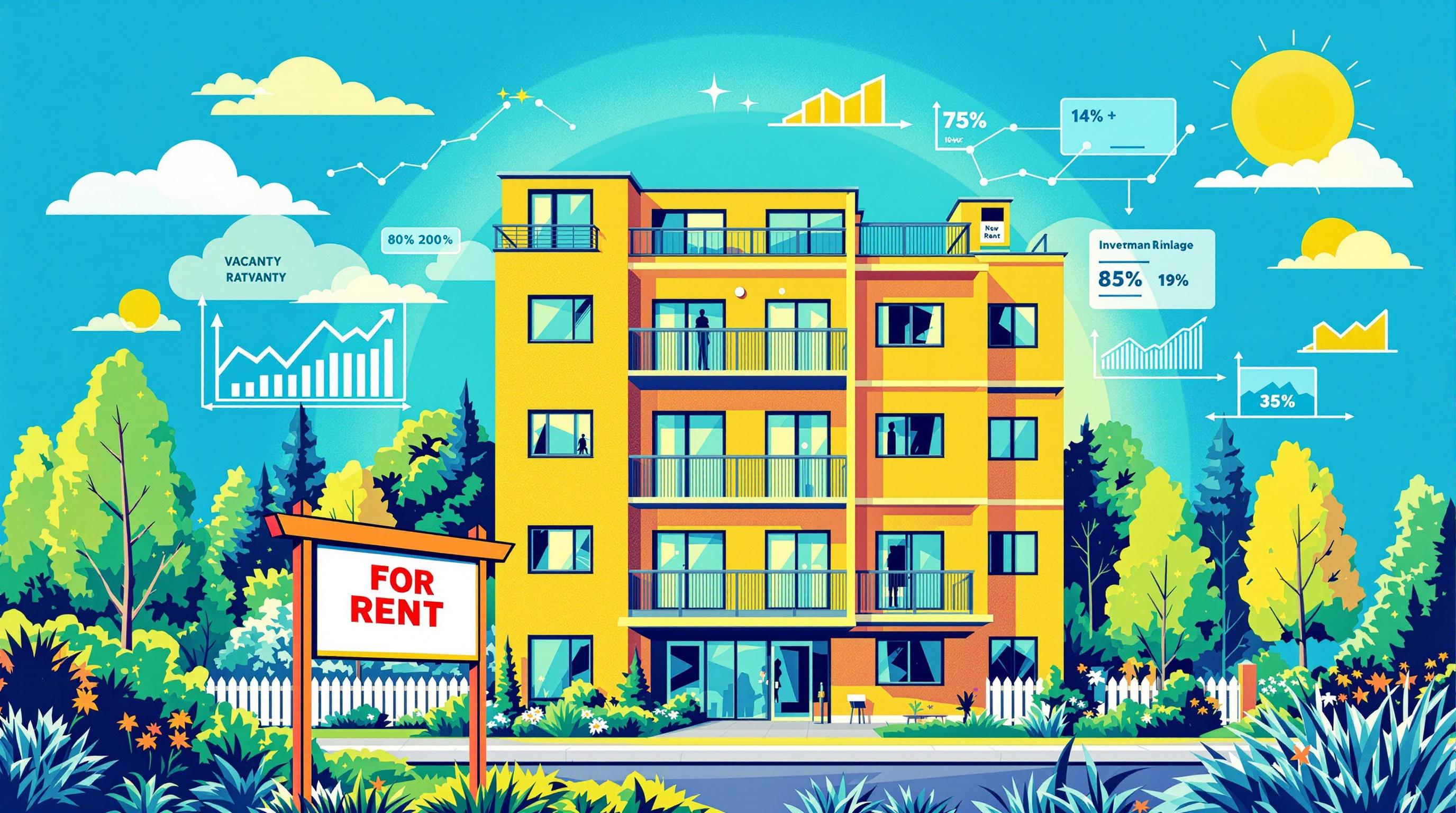Maintenance is essential to keeping rental properties in good condition, reducing costs, and improving tenant satisfaction. Two key strategies are preventive maintenance and predictive maintenance:
Quick Takeaways:
-
Preventive Maintenance: Scheduled tasks to prevent breakdowns (e.g., HVAC servicing twice a year).
- Saves 12%-18% on costs.
- Simple and reliable but may lead to over-maintenance.
-
Predictive Maintenance: Uses real-time data (e.g., IoT sensors) to predict issues before they happen.
- Saves up to 30% on costs.
- Requires higher upfront investment but reduces emergency repairs by 40%.
Key Comparison:
| Aspect | Preventive Maintenance | Predictive Maintenance |
|---|---|---|
| Timing | Scheduled upkeep | Real-time, data-driven fixes |
| Costs | Moderate, ongoing | High upfront, lower long-term |
| Equipment Life | Extends lifespan | Prolongs lifespan by ~30% |
| Technical Needs | Basic tools and skills | Advanced sensors and analytics |
| Savings | 12%-18% cost reduction | 25%-30% cost reduction |
Which Should You Choose?
- Use preventive maintenance for routine tasks like HVAC filter changes.
- Apply predictive maintenance for critical systems where downtime is costly.
- A mixed approach often works best for balancing costs and tenant satisfaction.
Both methods protect property value and improve tenant experiences. Dive into the article for details on implementation and real-world examples.
Preventative vs. Predictive Maintenance
Preventive Maintenance Basics
What Is Preventive Maintenance?
Preventive maintenance is all about staying ahead of problems. It involves scheduled upkeep to keep rental properties in good shape and tackle potential issues before they turn into expensive repairs. Andrew Smallwood, Chief Customer Officer at Second Nature, puts it this way:
"Preventive maintenance is a proactive approach to keeping a property in good condition with the purpose of preventing unexpected failures and maximizing longevity." [3]
For multi-family properties, this often means systematic checks, while single-family homes typically depend on residents to initiate maintenance tasks [3].
Common Preventive Maintenance Tasks
Property managers usually schedule tasks based on seasonal changes and the expected lifespan of assets. For instance, a March 2023 study by Landlordology highlighted the importance of regular HVAC servicing:
"I arrange to have an HVAC company service my rental properties twice a year. At that time, a technician checks the heating and air conditioning systems, changes the filters, and makes sure everything is working properly." – Laura Agadoni, Editor-in-Chief at Landlordology [4]
Here’s a breakdown of key tasks and their recommended schedules:
| Maintenance Task | Recommended Frequency | Why It Matters |
|---|---|---|
| HVAC System Service | Twice yearly | Reduces breakdowns and extends equipment life |
| Water Heater Flush | Twice yearly | Avoids costly replacements ($1,000–$3,000) |
| Gutter Inspection | Spring and Fall | Prevents water damage and foundation issues |
| Smoke/CO Detector Tests | Annually | Ensures safety and legal compliance |
| HVAC Filter Changes | Every 3–6 months | Boosts air quality and system efficiency |
Pros and Cons of Preventive Maintenance
Using a filter delivery service, for example, has been shown to cut HVAC-related maintenance requests by 38% [3].
Advantages:
- Extends the life of equipment
- Reduces the likelihood of unexpected failures
- Improves safety and ensures compliance
- Helps stabilize maintenance budgets
- Increases tenant satisfaction
Challenges:
- Higher upfront labor expenses
- Risk of over-maintenance
Maintenance costs usually make up 10–25% of a property’s operating budget [5]. This sets the stage for comparing preventive strategies with predictive maintenance approaches.
Predictive Maintenance Methods
Predictive Maintenance Definition
Predictive maintenance takes a data-driven approach to servicing equipment, relying on real-time data to determine when maintenance is actually needed. Unlike scheduled preventive maintenance, this method uses tools like sensors, data analytics, and machine learning to anticipate equipment failures before they occur. By 2020, 30% of large property management firms had already adopted this approach [6]. This shift from routine schedules to real-time insights has led to the development of specialized tools for better efficiency.
Predictive Maintenance Tools
Here are some of the main technologies used in predictive maintenance:
| Technology Type | Function | Impact |
|---|---|---|
| IoT Sensors | Monitor equipment performance and conditions | Detect problems like water leaks or HVAC inefficiencies |
| Analytics Software | Process and analyze collected data | Spot patterns that signal potential failures |
| AI/Machine Learning | Use historical data to predict maintenance needs | Reduce unexpected breakdowns by up to 90% [7] |
| Smart Thermostats | Track HVAC system performance | Save an average of 15% on energy consumption |
These tools work together to create an efficient monitoring system. For example, if sensors detect reduced HVAC efficiency, they can send alerts for maintenance before a breakdown occurs [1].
Predictive Maintenance Benefits and Drawbacks
Predictive maintenance offers several advantages, including cutting emergency repairs by 40%, lowering operational costs by 10%, and reducing long-term maintenance expenses by up to 30% [6] [7].
Key Benefits:
- Extends equipment lifespan by about 30% [7]
- Reduces repair time by 60% [7]
- Enhances tenant satisfaction through proactive fixes
- Supports better decision-making with actionable data
Primary Challenges:
- High upfront costs for sensors and monitoring systems
- Requires technical skills for setup and maintenance
- Issues with data quality and accessibility
- Difficulties integrating with existing systems
- Concerns over privacy and security
sbb-itb-00c8bef
Direct Comparison: Preventive vs. Predictive
Method Differences
Preventive maintenance follows a set schedule, while predictive maintenance relies on real-time data to determine when service is needed. Here's a breakdown:
| Aspect | Preventive Maintenance | Predictive Maintenance |
|---|---|---|
| Timing | Scheduled based on time or usage | Based on real-time equipment condition |
| Resource Planning | Requires planned downtime | Targets specific needs to reduce disruption |
| Implementation | Uses standard tools and checklists | Relies on sensors and data analysis |
| Technical Requirements | Basic maintenance skills required | Requires advanced technical expertise |
| Decision Making | Guided by theoretical failure estimates | Driven by live equipment data |
Now, let's explore how these differences impact costs.
Cost Comparison
Predictive maintenance often leads to better long-term savings, even though it involves higher upfront expenses:
- Preventive maintenance provides a 5:1 return - every $1 spent saves $5 in future repairs [8].
- Predictive maintenance delivers a 10:1 ROI with 30%-40% cost savings [8].
- Switching from reactive to preventive maintenance can reduce maintenance costs by 12%-18% [8].
These cost factors also shape the effects on property conditions and tenant experiences.
"What properties will get with preventive maintenance is better energy efficiency, which leads to lower energy costs. It also leads to reduced repair costs, longer equipment life expectancy and increased occupant satisfaction. Residents aren't going to be angry all the time that something is broken." - Dina Mari Zemke, Associate Professor of Property Management at Ball State University [9]
Effects on Property and Tenants
Each approach impacts property value and tenant satisfaction in different ways:
Property Impact:
- Preventive maintenance keeps properties in steady condition with routine care.
- Predictive maintenance prolongs equipment life by addressing issues precisely when needed.
- Both approaches help avoid the steep costs of deferred maintenance, which can quadruple over time [8].
Tenant Experience:
- Preventive maintenance offers predictable schedules, allowing tenants to plan around them.
- Predictive maintenance reduces unexpected disruptions and emergency repairs.
- Both strategies contribute to better living conditions and higher tenant satisfaction, which directly influence a property's success [10].
Choosing between these approaches often comes down to factors like property size, budget, and management resources. Predictive maintenance can deliver stronger long-term results, but it requires a higher initial investment and specialized skills. Preventive maintenance, while simpler, remains a dependable and cost-effective option.
Selecting a Maintenance Plan
Decision Factors
When choosing a maintenance strategy, consider factors like property size, budget, asset types, technical expertise, and historical data. Here's a breakdown:
| Factor | Considerations | Impact |
|---|---|---|
| Property Size | Number of units, building complexity | Larger portfolios often benefit from predictive systems. |
| Budget | Upfront costs, long-term returns | Predictive maintenance has higher initial costs but can cut maintenance expenses by up to 30% [7]. |
| Asset Types | Critical systems, replacement difficulty | Remote or hard-to-replace assets justify predictive monitoring. |
| Historical Data | Equipment records, maintenance logs | More data improves predictive analysis effectiveness. |
Mixed Maintenance Approaches
To get the best results, combine different maintenance strategies based on specific needs:
- Critical Systems: Apply predictive maintenance to essential equipment where failures could disrupt tenants. This can reduce unexpected breakdowns by up to 90% [7].
- Routine Tasks: Use preventive maintenance for simpler tasks like replacing filters, seasonal HVAC servicing, and basic plumbing checks.
- Tech Integration: Leverage tools from companies like HappyCo, Mezo, and Lessen for digital inspections, automated work orders, and streamlined scheduling [2].
Implementation Steps
Once the strategy is set, follow these steps to put it into action:
-
Assessment and Planning
Begin with a pilot program on one critical system. Document and analyze the results before expanding. -
Technology Setup
Equip assets with the right monitoring tools. Here's a quick guide:Monitoring Method Warning Time Best Applications Ultrasonic Sensing Years ahead Detects early bearing failures. Vibration Monitoring Months ahead Tracks rotating equipment health. Thermography Lagging indicator Spots thermal issues in motors and other equipment. -
Team Development
Collaborate with specialized providers. Define clear protocols for response, data analysis, and regular evaluations. -
Continuous Improvement
Track metrics like mean time between failures, maintenance costs per square foot, tenant satisfaction, and equipment longevity. Expect up to a 25% efficiency boost and a 30% increase in equipment lifespan [7].
Summary
Key Points Review
Preventive and predictive maintenance bring different strengths to rental property management. Here's a side-by-side comparison of how they perform:
| Aspect | Preventive Maintenance | Predictive Maintenance |
|---|---|---|
| Cost Structure | Steady, ongoing costs | High upfront investment[1]; up to 75% lower long-term costs[5] |
| Implementation | Task scheduling based on time or usage | Relies on sensors and analytics for data-driven decisions |
| Equipment Life | Reduces regular wear and tear | Can increase equipment uptime by up to 20%[11] |
| ROI Timeline | Immediate, short-term benefits | Offers a 10:1 to 30:1 return within 3 years[11] |
| Breakdown Prevention | Routine servicing prevents issues | Reduces equipment failures by up to 45%[5] |
These insights highlight how both strategies can be applied effectively in property management.
"Predictive maintenance is the key to smoother operations and a healthier bottom line, offering foresight to prevent costly surprises." [11]
Kirin Property Management Services

Kirin Property Management, based in Nova Scotia, combines preventive and predictive maintenance for optimal results. Their services include:
- Real-time monitoring and reporting by in-house experts
- Maintenance schedules informed by data
- Emergency response protocols
This approach delivers measurable outcomes. For example, Michael T., a property owner in Dartmouth, Nova Scotia, saw his monthly rental income increase by $150 after enrolling in Kirin's program. By blending preventive and predictive strategies, Kirin helps property owners maximize performance while keeping costs under control.



